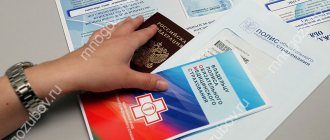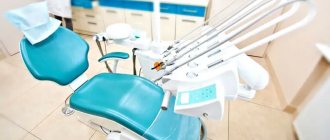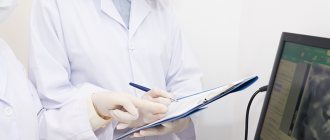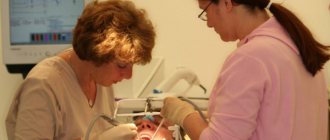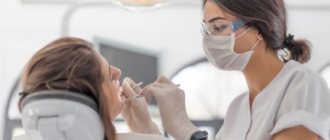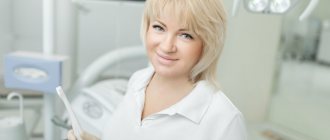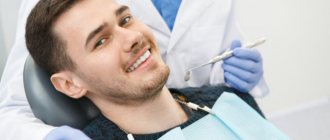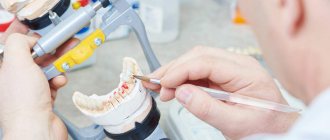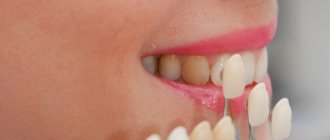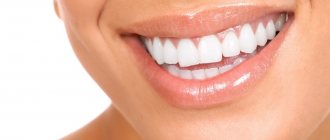General requirements for medical organizations
The basis for the development of SanPiN in dentistry is Law No. 52-FZ of 1999 “On the Sanitary and Epidemiological Welfare of the Population.” The rules given in the normative act apply to all forms of legal entities if they carry out measures to provide dental services.
SanPiN dental office
The rules are mandatory for compliance throughout the Russian Federation. SanPiN dentistry establishes the following requirements for dental organizations:
- correct design and placement of equipment;
- proper working conditions for the organization's employees;
- established sanitary and epidemiological regime.
Authorized bodies carry out sanitary and epidemiological supervision. Each dental company is required to have a copy of the Rules. Responsibility for compliance with the standards lies with legal entities, individual entrepreneurs, enterprise managers and responsible persons.
General rules and regulations of SanPin
General rules:
- The requirements apply to public clinics and legal entities that plan to open a dentistry.
- New clinics are built and equipped based on current rules and recommendations.
- New facilities are accepted and approved for operation by the state commission, which can issue a conclusion from the SES.
- Each dental organization must have an officially published copy of SanPin.
- Responsible for compliance with the requirements of the sanitary and anti-epidemiological regime are legal entities, their managers and other officials.
- During the construction and operation of dentistry, only those materials, products and devices that are permitted in Russia are used.
- All dental employees have a responsibility to sanitize work areas and carry out sterilization cleaning.
- The current SanPin also applies to dentistry offices where the hospital operates.
SES requirements for dental offices
A small office can be placed in almost any area. Requirements for a dental office 2022 SanPiN allow it to be located in the following places:
- on the first or second floor of a residential building;
- in a separate building;
- in an attached room or outbuilding.
Safety precautions in the pool: rules and SanPin
If a room from the residential stock was chosen as an office, you will need to move it to a non-residential one. This is a rather long procedure that requires approval from many government agencies. In addition, if the office is located in a residential building, it will be necessary to make a separate exit for it so that it is convenient for visitors.
Sanitary and hygienic requirements for dental medical organizations also put forward some requirements for the premises themselves. The room should have:
- high ceilings - more than 2.6 m;
- network engineering;
- area from 14 square meters + additional 10 sq. m. for all additional work chairs or +7 sq. m. m. for each chair with a drill.
Note! If the office has no more than 3 chairs, it is allowed to make one sanitary unit for clients and clinic employees. If there are more chairs, a separate toilet will need to be made for clients.
Personnel requirements
Dental office employees must have:
- higher or secondary medical education;
- takes advanced training courses every 5 years;
- have a medical record.
The medical record must contain the dates of all examinations of personnel, as well as information about courses to improve the level of knowledge regarding sanitary standards.
On personnel hygiene
Medical staff should be provided with several sets of spare clothes. This:
- shoes;
- dressing gowns or special suits;
- hats;
- masks.
Changes of clothing should be stored separately in individual lockers. Outerwear must be kept in the wardrobe during working hours.
Sanitary clothing should be changed daily, regardless of the type of medical facility. Clothing stained with blood should be changed immediately.
During treatment procedures, the patient is prohibited from touching food, taking notes, picking up third-party objects, etc.
Hand treatment
All employees of the dental clinic, be it a doctor, consultant or orderly, must wash their hands thoroughly and ensure that the following requirements are met:
- It is forbidden to grow long nails or paint them with varnish;
- Do not wear jewelry on your fingers while working;
- Dental surgeons should refrain from wearing watches, bracelets or rings;
- After treatment, personnel should dry their hands with paper or cloth napkins.
To treat your hands, you can use soap and warm water or an antiseptic, which can help reduce the number of germs on the skin.
To the equipment
If an X-ray installation is required in a work room, when arranging it, you should be guided by SanPiN 2.6.1.1192-03.
Premises requirements
If natural light enters the room from one side, then the chairs should be placed along a light-carrying wall. The seats must be separated by opaque partitions at least one and a half meters high.
The room must have at least two sinks. One is for patients, the second is for processing equipment.
For disinfection
All dental instruments used for surgical purposes must be amenable to manual or mechanized disinfection. For this purpose, disinfectants with a wide range of applications are used.
Disinfection by wiping can be done for those items that do not come into contact with the patient or that cannot be disinfected by immersion. What a sterilization room in dentistry should look like, the requirements are specified in SanPiN.
Important! Disinfection occurs in separate sterilization rooms. If there are no centralized special rooms for the procedure, instruments are cleaned in departments of medical institutions.
Instruments for sterilization
After the procedure, the products should be dried until the moisture disappears. For this purpose, special drying cabinets are used. Processing of dental mirrors according to SanPiN follows the same procedure as for all other semi-critical items. They are subjected to high-level disinfection using chemical disinfectants.
Towards radiation safety
The location of X-rays in rooms must comply with radiation safety standards that define radiation protection criteria.
During procedures, the radiation doses received by patients and clinic staff must be recorded and recorded. All information must be reflected in the radiation-hygienic passport.
Important! To carry out radiological activities, the organization must have an appropriate license.
Requirements for dentistry for natural and artificial lighting
SanPiN of a dental office says that every such room must have a source of natural light. The current version of the rules states that it is recommended to orient windows to the north in order to avoid bright light and overheating of the room in the summer. Otherwise, in the southern regions of the country in the summer it will be necessary to use sun-protection structures.
If the offices have only one-way natural lighting, but the chairs are arranged in two rows, artificial lighting should also be used.
A source of artificial lighting must be installed in each room of the dental clinic. General lighting points should be located so as not to fall into the field of view of the treating dentist.
Lighting
Area of responsibility during interventions.
In accordance with clause 3.2 of SanPiN 3.1.3263-15, in each structural unit of a medical organization performing endoscopic intervention, persons responsible for organizing and carrying out anti-epidemic measures, including the quality of processing of endoscopic equipment, must be identified.
The head (doctor) of the structural unit (office) performing endoscopic interventions must develop work instructions for processing endoscopes available in the equipment of the structural unit (office), which is approved by the head of the medical organization. The specified instructions must be drawn up on the basis of the provisions of these sanitary rules, taking into account the type, brand (model) of endoscopes, operational documentation for them and equipment intended for their processing and storage, instructions for the use of chemical cleaning, disinfection and sterilization agents used (clause 3.3 of SanPiN 3.1.3263-15).
Doctors directly involved in performing endoscopic interventions and processing endoscopic equipment must undergo advanced training at least once every five years on the basis of organizations licensed to conduct educational activities under programs of additional professional education, including issues of ensuring the epidemiological safety of endoscopic interventions (clause 3.4 SanPiN 3.1.3263-15).
Each endoscope equipped at a structural unit in which endoscopic interventions are performed is assigned an identification number, which includes information about its type, model and serial number. The identification number of the endoscope used during a medical intervention must be indicated in the endoscopic intervention protocol, in the special notes column of the journal for recording studies performed in the endoscopy department, or in the journal for recording surgical interventions (clause 3.6 of SanPiN 3.1.3263-15).
Sanitary requirements in dentistry for microclimate, heating and ventilation
SanPiN: noise standards, level in the workplace
Design standards in dentistry are the same as for residential and public buildings. Ventilation, heating and air conditioning systems must comply with these rules.
Ventilation systems, if the office is located in a residential building, must be separate for the dental premises. To ensure good climatic conditions, it is possible to install an air conditioner. In this case, fine filters will need to be changed every six months.
Equipment location
Heating surfaces must be smooth so that they can be easily cleaned from dust and germs. In laboratories and operating rooms, equipment should be used that has a surface that is resistant to disinfectants.
Design and installation
Ventilation is a completely individual system. There are no ready-made solutions, and any search and chaotic purchase of some equipment will lead to large losses.
When working on ventilation, we always start with design. Without a project, it is impossible to find out the exact cost, purchase materials and carry out installation work.
Without a project, it is impossible to even adjust the grilles and air exchange in each room. In the project, we perform air exchange calculations, select the cross-section of air ducts and diffusers, and carry out design balancing of the system.
The finished project becomes the basis for concluding an installation contract.
We begin installation work with the purchase of equipment. Any equipment is manufactured within 4-6 weeks. During this time, installers will be able to purchase air ducts and install the main wiring, install air conditioners, lay freon pipes and drainage lines.
Requirements for dental premises and interior decoration
The rules put forward requirements for the interior decoration of the premises, namely:
- walls in corners and joints must be smooth and without cracks;
- all wall finishing materials must be approved for use in such premises. You should also pay attention to their resistance to disinfectants;
- Water-based and other paints are used for ceilings. Suspended ceilings can only be used if this does not affect the standard height of the room;
- the color of ceilings and walls should be light and neutral.
Important! For each material used for finishing the premises, it is necessary to have certificates of conformity. Not all materials on the market are suitable for dental offices. Information on compliance can be read in the documentation for the materials or checked with the manufacturer.
Minimum set of premises and their minimum area
The set of premises of a particular medical organization providing medical care in the “Dentistry” profile is determined by the capacity of the dental medical organization and the types of activities.
The minimum area of premises and their minimum set are presented in Appendix 2 to SanPiN 2.1.3.2630-10.
Currently, the minimum set of premises for the work of a dental medical organization includes:
- lobby group,
- dentist's office,
- staff room,
- toilet,
- pantry.
In other words, a dental office cannot function on its own. To organize a dental clinic, there must be not only a dentist’s office, but also the entire minimum set of premises that are listed above. If the doctor’s office or offices are located inside another medical organization, then additional premises included in the mandatory composition can be used by them on a joint use basis. Then the dentist’s office(s) has a chance to obtain the status of a medical organization and undergo all the necessary approvals and, ultimately, a license to carry out medical activities. However, such placement criteria are not always approved by supervisory authorities.
Table 1 below shows the truncated composition, set and minimum recommended premises of a dental medical organization. The full version of this table is available in Appendix 2 to SanPiN 2.1.3.2630-10.
Table 1.
Composition, set and minimum recommended areas of premises of a dental medical organization
| Name of premises | Minimum area, sq.m. | Notes |
| Lobby area with reception desk, outerwear wardrobe and waiting room | 10 | For each adult patient 1.2 sq.m. For each child, including the stay of one of the parents - 2 sq.m. |
| Doctor's office (dentist therapist, surgeon, orthopedist, orthodontist, pediatric dentist) | 14 | With an increase of 10 sq.m for each additional dental unit (7 sq.m per additional dental chair without installation). |
| X-ray room for one* dental X-ray machine for targeted images | 6 | Reducing the area is possible subject to paragraph 7.2.1 of section. Chapter 7 5 |
| Administrative, utility and auxiliary premises: | ||
| Staff room with wardrobe | 6 | For each person working per shift, 1.5 sq.m. Outerwear can be placed in a wardrobe |
| Head nurse's office | 8 | |
| Storage room for medicines and narcotic materials | 6 | |
| Storage rooms for medical products | 6 | Can be placed in wardrobes in corridors and basements |
| Dirty laundry closet | 3 | |
| Clean linen storage room | 3 | |
| Patient toilet | 3 | If the number of dental chairs in a dental medical organization is no more than 3, it is allowed to have one toilet for patients and staff |
| Staff toilet | 3 |
* Areas for other offices and auxiliary rooms of the radiology department are in the current sanitary rules regulating the requirements for sources of ionizing radiation.
We especially emphasize that in dental offices the area for the main dental unit should be at least 14 sq.m, for an additional unit - 10 sq.m (for a dental chair without a drill - 7 sq.m), the height of the offices - at least 2.6 m.
Nota bene! When choosing premises for a dental clinic (dental office) and determining the set of its premises, the Faculty of Medical Law recommends taking into account that
- Dental appointments for children are carried out in separate rooms. It is not permitted to use adult reception rooms to receive children on a scheduled basis. To organize the reception of children, if possible, a separate compartment with a waiting area and a bathroom should be allocated.
- Medical care for pregnant women is provided in medical dental organizations for adults or in dental offices of antenatal clinics.
- Surgical interventions, for which medical activities in anesthesiology and resuscitation are carried out, are carried out in the conditions of the operating room. At the same time, a room is equipped for the patient’s temporary stay after surgery. In the operating room, the supply of medical gases is provided if necessary.
- The office of a dental surgeon must be a separate room that cannot be used for the work of other dentists. The work of a surgical dentistry office should be organized taking into account the separation of flows of “clean” (planned) and “purulent” interventions. Planned interventions are carried out on specially designated days with preliminary general cleaning.
- The placement and operation of X-ray rooms and devices (including radiovisiographs) are regulated by current regulatory documents and paragraph 7 of Chapter 5 of SanPiN 2.1.3.2630-10. Read more about this in another section of the articles “Commissioning of an X-ray room (sources of ionizing radiation).”
Algorithm for performing current cleaning activities
The areas where dentists work require regular cleaning every day. Routine cleaning of premises should be carried out at least twice. If work is carried out in two shifts, then cleaning should be done three times.
Note! Cleaning can be done by wiping or sprinkling. It is customary to wipe flat surfaces, and use irrigation only for joints and other hard-to-reach areas of equipment or furniture.
The routine cleaning procedure includes the following steps:
- wiping tables;
- cleaning dirt from armchairs, cabinets, chairs;
- washing sinks and other plumbing fixtures;
- At the end of the procedure, the floors are washed.
After cleaning, disinfection occurs with bactericidal lamps.
Sanitary measures in the endoscopy room.
Special requirements are imposed on sanitary measures carried out in the endoscopy room. Thus, in accordance with clause 5.16 of SanPiN 3.1.3263-15, cleaning and preventive disinfection in manipulation rooms for non-sterile endoscopic interventions, in the washing and disinfection room should be carried out as they become dirty, but at least once per shift or twice a day. After each patient, the surface of the couch must be disinfected. General cleaning should be done once a week.
All types of cabinets for storing processed endoscopes must be cleaned and disinfected with a chemical solution in a bactericidal mode at least once a week, unless otherwise provided in the operating instructions (clause 5.15 of SanPiN 3.1.3263-15).
Preliminary cleaning of used endoscopes and instruments for them is carried out in the same room where the intervention was carried out (clause 5.6 of SanPiN 3.1.3263-15). Final cleaning (final cleaning combined with disinfection) and high-level disinfection of endoscopes intended for non-sterile endoscopic interventions are carried out in a specially equipped washing and disinfection room or room for processing endoscopes (clause 5.7 of SanPiN 3.1.3263-15).
When processing endoscopes and other medical products as part of endoscopic and endosurgical complexes, as well as instruments for endoscopes, medical equipment products, sterilizers, washing machines, ultrasonic cleaners, detergents and disinfectants approved for use for these purposes in the Russian Federation must be used.
It is extremely important that when choosing cleaning, disinfection, as well as sterilization products and methods, the recommendations of manufacturers of endoscopes and instruments for them regarding the impact of a particular product on the materials of these medical devices should be taken into account. It is not allowed to use disinfectants for cleaning or cleaning combined with disinfection, which in the recommended modes have a fixing effect on organic contaminants, including those containing alcohols and aldehydes (clause 7.3 of SanPiN 3.1.3263-15).
How to properly dispose of waste
Only a person who has received the appropriate certificate can dispose of waste in a medical facility. Each medical institution must have its own “Instructions on the procedure for collecting, storing and disposing of waste.”
Important! All waste that occurs as a result of the activities of a medical facility, including human tissue, secretions and fluids, medical materials (syringe tips, bandages, clothing, etc.), if they can be contaminated, pose a danger to human health. For this reason they must be disposed of.
The waste disposal procedure depends on its type:
- food waste and solid household waste should be thermally treated or buried in a landfill after disinfection;
- biological materials and plastic products must be processed using thermal methods;
- pharmaceutical waste and radioactive substances (including mercury) can only be destroyed at special enterprises.
In the latter case, the clinic is only responsible for packaging and transporting waste.
Structure, composition, technical features of premises.
In accordance with clause 5.1 of SanPiN 3.1.3263-15, the endoscopy department (office) must have the following premises:
1) doctor's office;
2) separate endoscopic manipulation zones (depending on the types of interventions performed) for:
- bronchoscopy; studies of the upper gastrointestinal tract;
- studies of the lower gastrointestinal tract;
3) washing and disinfection room;
4) auxiliary premises.
To conduct studies of the lower parts of the digestive tract, a sanitary facility must be provided (clause 5.3 of SanPiN 3.1.3263-15).
It is important to note that the manipulation room for bronchoscopy belongs to cleanliness class B; this room is equipped with a supply and exhaust ventilation system with a predominance of air flow. The supplied air must be cleaned and disinfected with an efficiency of at least 95%. The room for processing endoscopes should be equipped with general supply and exhaust ventilation and local exhaust ventilation with removal of solution vapors at the level of the washing baths.
The room in which endoscopic interventions are performed must be equipped with a sink for washing the hands of medical workers, with hot and cold water supply, including a backup hot water supply.
Note:
The location of technological equipment in the room for processing endoscopes must ensure the flow of all stages of processing endoscopes in accordance with the requirements of sanitary rules. In newly designed medical organizations, planning solutions should be provided that eliminate the cross-flow of clean and dirty endoscopes. For existing offices, the endoscope processing room is functionally divided into a conditionally dirty area, intended for final cleaning, and a conditionally clean area, where high-level disinfection, drying and storage of endoscopes is carried out. A sink is installed in the endoscope processing room for medical personnel to wash their hands. It is not permitted to be used for other purposes.
